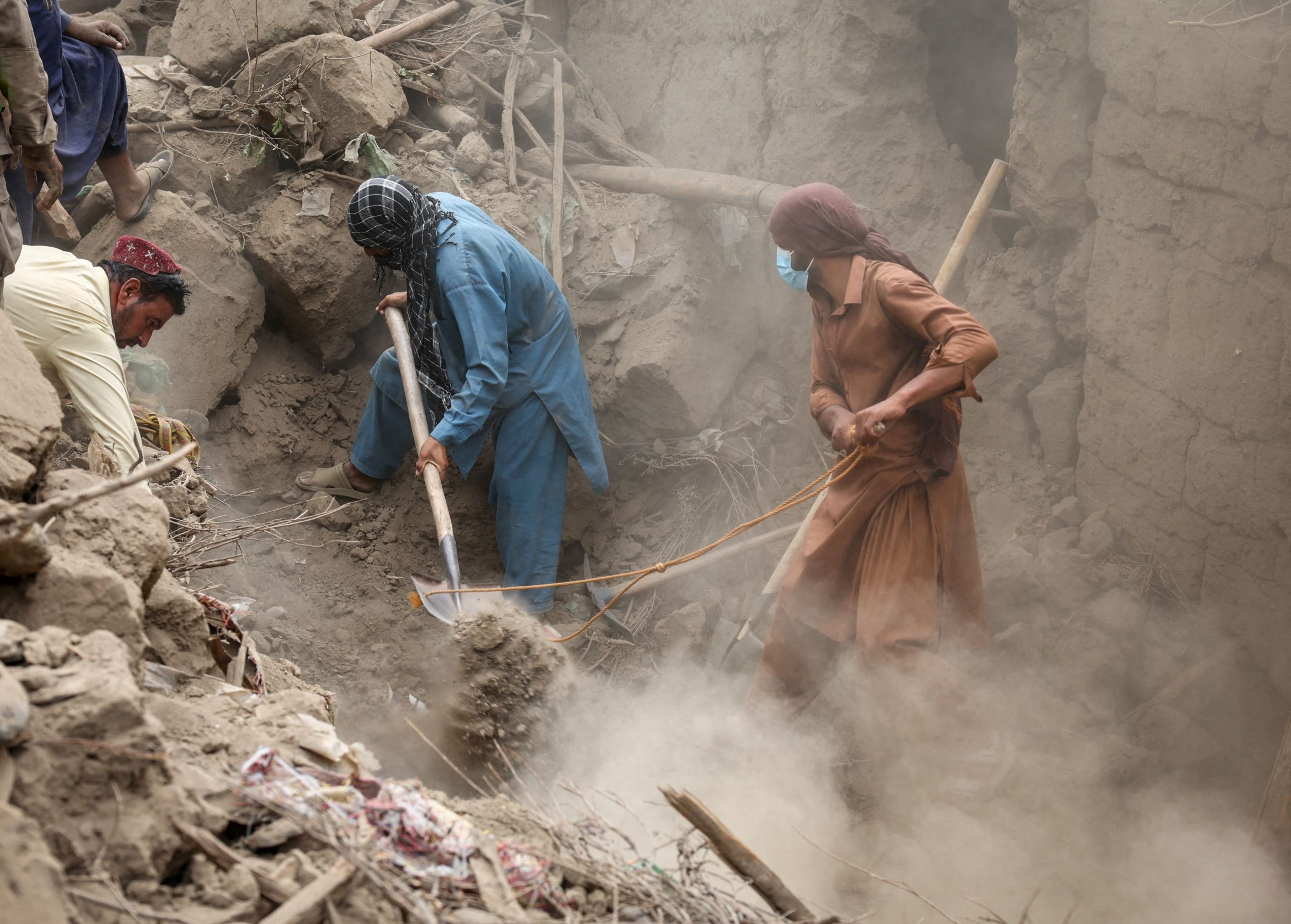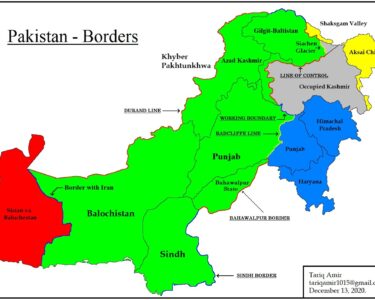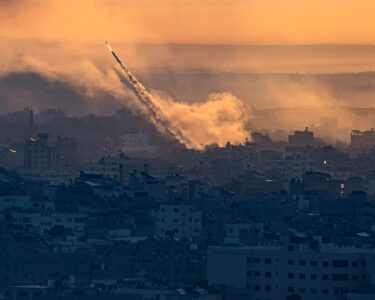- Summary
- Two powerful aftershocks strike within 12 hours
- More than 6,700 homes destroyed, survivors stay in the open
- Rescuers slowed by landslides, blocked roads, rough terrain
- WHO warns of disease, overcrowding, lack of sanitation
- UN says money running low, plans emergency funding appeal
JALALABAD, Afghanistan, Sept 5 (AfrikTimes) – Two powerful aftershocks struck eastern Afghanistan 12 hours apart, triggering fears of more deaths and destruction on Friday in a region where earthquakes have killed about 2,200 people as rescuers battled mountainous terrain and harsh weather.
Survivors in the earthquake-prone region are scrambling for basic amenities as the United Nations and other agencies warn of a critical need for funds, food, medical supplies and shelter, with the World Health Organization seeking funds of $4 million. The latest aftershocks follow two earthquakes that ravaged a nation already crushed by war, poverty and shrinking aid.
The Taliban administration estimated 2,205 deaths and 3,640 injuries by Thursday.
 A boy stands in front of houses damaged by a deadly earthquake that struck Afghanistan’s Kunar and Nangarhar provinces, at Masud village in Nurgal district, Kunar province, Afghanistan, September 4, 2025.
A boy stands in front of houses damaged by a deadly earthquake that struck Afghanistan’s Kunar and Nangarhar provinces, at Masud village in Nurgal district, Kunar province, Afghanistan, September 4, 2025.
Ambulances ferried to hospital 13 people injured after Thursday night’s tremor of magnitude 6.2 in Nangarhar province, with its epicentre in the district of Shiwa near the Pakistan border, said regional health spokesman Naqibullah Rahimi.
“Ten were discharged after treatment and three were in stable condition, he added.
A witness said details of the damage were still being collected after continuous aftershocks in Nangarhar, with its capital Jalalabad about 150 km (95 miles) from Kabul.
“Friday’s earthquake of magnitude 5.4 struck the southeast at a depth of 10 km (6.2 miles), the German Research Center for Geosciences (GFZ) said, just hours after Thursday’s event.
With houses built mostly of dry masonry, stone, and timber, some families preferred to stay in the open to guard against shocks, rather than return home. Residents of the Nurgal district of Kunar have left their homes to live in tents, on the surrounding high land near a river, or in the open, for fear of more tremors.
“Fallen rocks and earth blocked access to some badly affected villages, holding up rescue and relief efforts, they said.
 A doctor applies pain relieving spray to the shoulder of an Afghan man following a deadly earthquake that struck Afghanistan’s Kunar and Nangarhar provinces, in Nurgal district, Kunar province, Afghanistan, September 4, 2025.
A doctor applies pain relieving spray to the shoulder of an Afghan man following a deadly earthquake that struck Afghanistan’s Kunar and Nangarhar provinces, in Nurgal district, Kunar province, Afghanistan, September 4, 2025.
The week’s first earthquake of magnitude 6, just before midnight on Sunday, was one of Afghanistan’s deadliest, unleashing damage and destruction in Nangarhar and Kunar provinces when it struck at a shallow depth of 10 km (6 miles). A second quake of magnitude 5.5 on Tuesday caused panic and interrupted rescue efforts as it sent rocks sliding down mountains and cut off roads to villages in remote areas.
The two initial quakes flattened entire villages in both provinces, destroyed more than 6,700 homes, and left rescuers pulling bodies from the rubble as late as Thursday. Afghanistan sits on a seismic fault line where the Indian and Eurasian tectonic plates collide, making the Hindu Kush region one of the most earthquake-prone zones in the world.
 Rad Bibi, an Afghan woman who claims to be 110-years-old, shows her injured leg as she sits in a cot outside her damaged house following a deadly earthquake that struck Afghanistan’s Kunar and Nangarhar provinces, in Nurgal district, Kunar province, Afghanistan, September 4, 2025.
Rad Bibi, an Afghan woman who claims to be 110-years-old, shows her injured leg as she sits in a cot outside her damaged house following a deadly earthquake that struck Afghanistan’s Kunar and Nangarhar provinces, in Nurgal district, Kunar province, Afghanistan, September 4, 2025.
FUNDING CRISIS
Landslides and debris blocking key roads have slowed relief operations, the World Health Organization (WHO) said, renewing calls for urgent international assistance to support healthcare delivery and disease surveillance in quake-hit Afghanistan.
“A funding gap of at least $4 million threatens to delay critical activities, underscoring the urgent need for international support,” the WHO warned in a statement. It also flagged rising risks of disease outbreaks caused by overcrowded shelters, unsafe water, and poor waste management. The fragile healthcare system is further strained by the influx of Afghans recently deported from Pakistan.
Afghanistan’s Taliban government appealed for emergency aid soon after Sunday’s deadly quake, but relief has been limited in a country largely cut off from international support since the Taliban’s return to power in 2021. The crisis is compounded by drought in the north and the return of millions of Afghans expelled from Iran and Pakistan.
 A vehicle loaded with tents and other essential supplies is headed to a quake-hit area following a deadly earthquake that struck Afghanistan’s Kunar and Nangarhar provinces, in Nurgal district, Kunar province, Afghanistan, September 4, 2025.
A vehicle loaded with tents and other essential supplies is headed to a quake-hit area following a deadly earthquake that struck Afghanistan’s Kunar and Nangarhar provinces, in Nurgal district, Kunar province, Afghanistan, September 4, 2025.
The United Nations, which has said money to help quake victims will run out soon, plans to launch an emergency appeal for funds, a senior official in the country said. It has released $10 million, more than the trickle of cash announced by rich nations, though some have sent assistance such as tents.
“We have some seed funding, but we are looking to make a flash appeal,” said Kate Carey, deputy head of the UN’s humanitarian affairs coordination office in Afghanistan.
 Sadiq, 12, an Afghan boy who survived after being trapped in rubble, sits with his relatives following a deadly earthquake that struck Afghanistan’s Kunar and Nangarhar provinces, in Nurgal district, Kunar province, Afghanistan, September 4, 2025.
Sadiq, 12, an Afghan boy who survived after being trapped in rubble, sits with his relatives following a deadly earthquake that struck Afghanistan’s Kunar and Nangarhar provinces, in Nurgal district, Kunar province, Afghanistan, September 4, 2025.
Reporting by AfrikTimes’ Adebukola Samuel Adeagbo, Reuters’ Mohammad Yunus Yawar in Kabul, Charlotte Greenfield and Saeed Shah in Islamabad; Additional reporting by Nilutpal Timsina in Bengaluru




 A boy stands in front of houses damaged by a deadly earthquake that struck Afghanistan’s Kunar and Nangarhar provinces, at Masud village in Nurgal district, Kunar province, Afghanistan, September 4, 2025.
A boy stands in front of houses damaged by a deadly earthquake that struck Afghanistan’s Kunar and Nangarhar provinces, at Masud village in Nurgal district, Kunar province, Afghanistan, September 4, 2025. A doctor applies pain relieving spray to the shoulder of an Afghan man following a deadly earthquake that struck Afghanistan’s Kunar and Nangarhar provinces, in Nurgal district, Kunar province, Afghanistan, September 4, 2025.
A doctor applies pain relieving spray to the shoulder of an Afghan man following a deadly earthquake that struck Afghanistan’s Kunar and Nangarhar provinces, in Nurgal district, Kunar province, Afghanistan, September 4, 2025.  Rad Bibi, an Afghan woman who claims to be 110-years-old, shows her injured leg as she sits in a cot outside her damaged house following a deadly earthquake that struck Afghanistan’s Kunar and Nangarhar provinces, in Nurgal district, Kunar province, Afghanistan, September 4, 2025.
Rad Bibi, an Afghan woman who claims to be 110-years-old, shows her injured leg as she sits in a cot outside her damaged house following a deadly earthquake that struck Afghanistan’s Kunar and Nangarhar provinces, in Nurgal district, Kunar province, Afghanistan, September 4, 2025. A vehicle loaded with tents and other essential supplies is headed to a quake-hit area following a deadly earthquake that struck Afghanistan’s Kunar and Nangarhar provinces, in Nurgal district, Kunar province, Afghanistan, September 4, 2025.
A vehicle loaded with tents and other essential supplies is headed to a quake-hit area following a deadly earthquake that struck Afghanistan’s Kunar and Nangarhar provinces, in Nurgal district, Kunar province, Afghanistan, September 4, 2025. Sadiq, 12, an Afghan boy who survived after being trapped in rubble, sits with his relatives following a deadly earthquake that struck Afghanistan’s Kunar and Nangarhar provinces, in Nurgal district, Kunar province, Afghanistan, September 4, 2025.
Sadiq, 12, an Afghan boy who survived after being trapped in rubble, sits with his relatives following a deadly earthquake that struck Afghanistan’s Kunar and Nangarhar provinces, in Nurgal district, Kunar province, Afghanistan, September 4, 2025.


